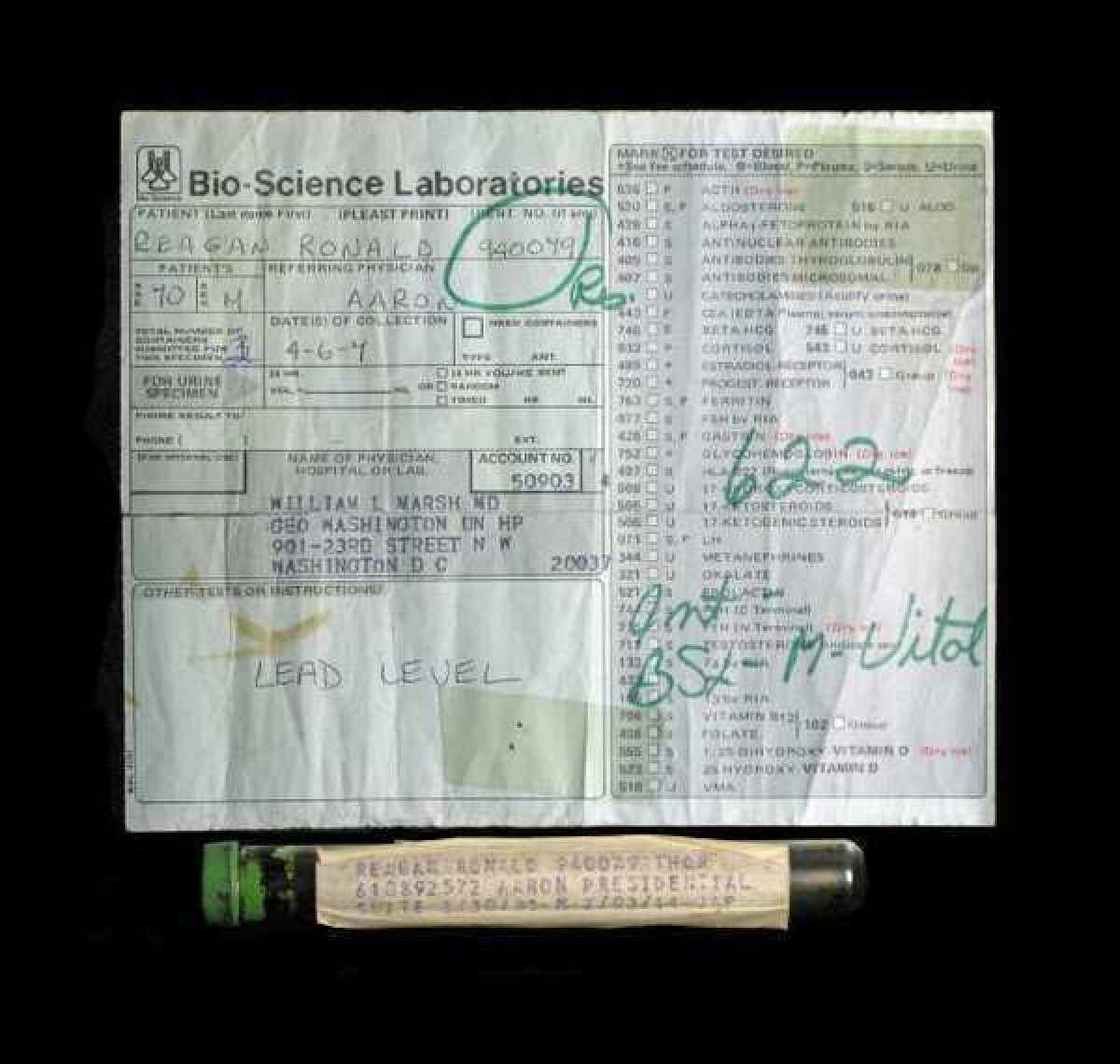Reagan blood vial -- ghoulish or historical?

- Share via
Somebody may have been taking that phrase “Saint Ronnie” a little too literally.
Or he was taking “Reaganomics” too literally.
A glass vial purportedly containing residue of President Reagan’s type-O blood, from the March 1981 day when an assassin nearly killed him, was put up for sale by a British auction site about three weeks ago, and bidding had reached $30,000 before the seller took the item off the market and is donating it to the Reagan Presidential Foundation.
According to the auction house site, the seller of the vial had actually bought it at a U.S. auction in February, and the owner was reselling it. The auction website quotes the anonymous consigner as saying he bought the “important artifact” because he is “a serious collector of presidential memorabilia, and have donated to museums before, and thought from the provenance supplied at the auction where I purchased, that the Reagan Foundation had no interest in the item.”
Again according to the auction house, it will now be donated instead to the Ronald Reagan Foundation. “Disgust” would not be too strong a word to use to describe the foundation’s and the family’s reaction to the auction; the foundation had called the sale a “craven” act. Now it’s praising the owner for his “generous donation to the foundation.”
All of which seems, along with the paperwork, to endorse the authenticity of the glass vial. The original seller -- who is evidently not the current owner -- says he got it from his mother, who worked in the Maryland lab where the blood was sent as doctors in Washington worked to save Reagan’s life after he was shot by John Hinckley Jr. The original seller says his mother got permission to take the vial and the file after the bloodwork had been completed.
In the same fashion that comedy equals tragedy plus time, as the saying goes, the difference between ghoulish and historical may also be up to the calendar as much as the collectors’ market.
Catholics have venerated saints’ relics -- bones, hair and the like -- for centuries, in part for their putative power to work healing miracles. In the Middle Ages, enough purported fragments of the True Cross, on which Jesus was crucified, existed across Europe to build a forest of crosses.
Objects with any personal connection to famous and beloved American presidents have always fetched high prices from collectors, and the more intimate a connection, the better.
The sale of grisly presidential relics is not unknown. Two scraps of the leather upholstery of the presidential limousine stained with President John F. Kennedy’s blood were put up for auction a couple of years ago. Their provenance was verified by a White House employee named F. Vaughn Ferguson, who looked after the presidential limousines and who kept the leather after investigators had ripped the seats apart. (EBay is among the auction sites banning the sale of any such bodily objects, allowing only the sale of human hair, like bits preserved in lockets or braided into commemorative jewelry.)
And of course, relics of Abraham Lincoln’s life and death command huge prices and great reverence. A New Jersey historical society claims to have a bloodstained strip of linen from the bed on which Lincoln died. A Lincoln museum put on display the bloody kid gloves Lincoln had in his pocket in his box at Ford’s Theatre when he was shot.
There’s even a book, “Assassination Vacation,” a tour of venues connected to the murders of American presidents.
The term “Saint Ronnie” has been used to mock conservatives’ devotion to the president who, in contrast to GOP tenets of today, looks rather moderate and certainly pragmatic. I wouldn’t have been the least bit surprised to hear that among the bidders for the blood vial were ardent fans of the late president who would have been thrilled to own some of Reagan’s very essence. (And really, wouldn’t you, reading this, get even a momentary thrill at the thought of owning a singular object from a president or public figure you admire?) The current seller himself claimed, “I was a real fan of Reaganomics, and felt that President Reagan himself would rather see me sell it rather than donating it.”
I wonder whether the vial that held the blood of the 40th president will at some point in the distant future go on display in the Reagan Library in Simi Valley?
It’s a curious kind of homage, but the obsession with these objects also reflects the significance of the act of assassination. As grievous as an assassination is for the victim’s family, it is more than a murder -- it is an attack on the democratic process, an attempt to subvert the ballot box with a bullet. Imagining the alternate realities of an America with a President Robert F. Kennedy -- or without a President Reagan -- gives you a sense of why this is a crime not just against a human body but against the body politic.
That’s one reason why I argued in a column against the Robert Kennedy family’s campaign against preserving the Ambassador Hotel site of the assassination of June 1968. To stand where the unimaginable happened -- as Americans can in Dealey Plaza in Dallas and Ford’s Theatre just as they can at Gettysburg and Independence Hall -- gives Americans a sense of the scale and reality of epochal history that no virtual experience -- and no single artifact -- can convey.
RELATED:
Auctioning off a gruesome piece of history
Creepy collectors and the bidding on a venerated president’s blood
More to Read
A cure for the common opinion
Get thought-provoking perspectives with our weekly newsletter.
You may occasionally receive promotional content from the Los Angeles Times.










